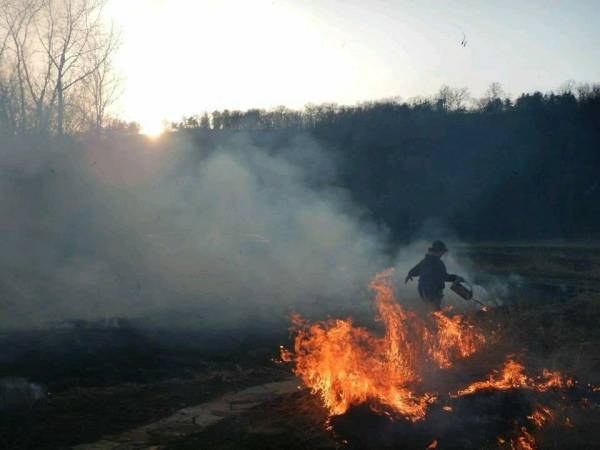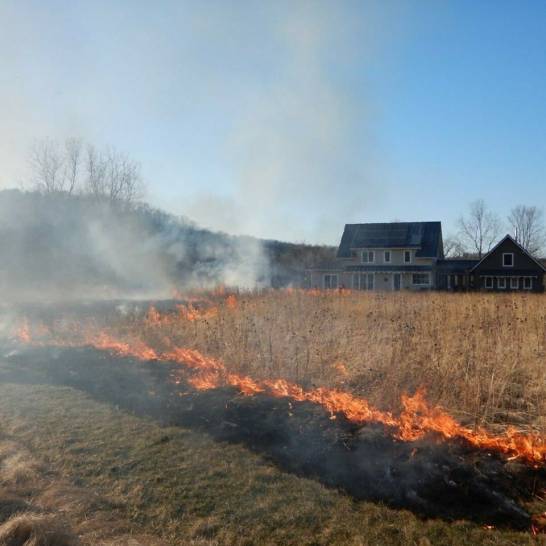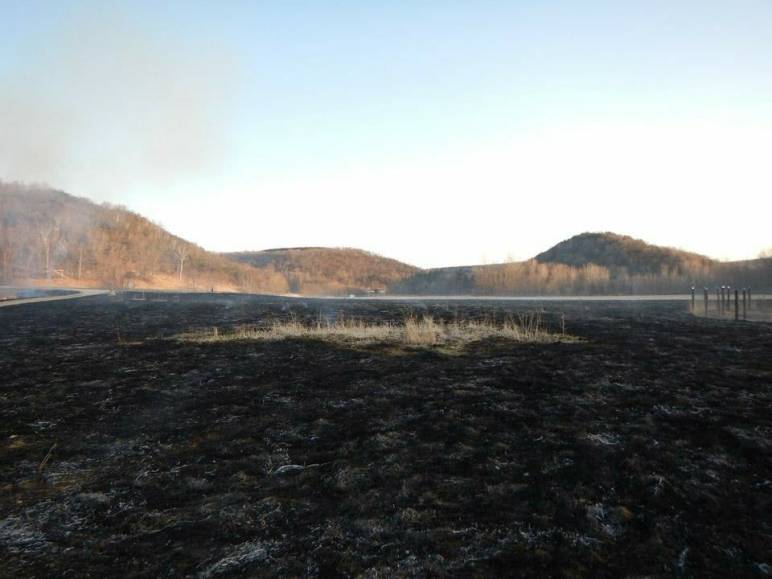Spring. The word brings to mind green leaves, light breezes, the sunshine warming my skin. In Minnesota, spring means warmth, but not just from the sun. It is burn season.
At Eagle Bluff we’ve completed our controlled burns for the year. While many of our staff members are familiar with the process, the endeavor was new to me. Naturally, this means I was assigned the duty of setting the fire. Learning happens most quickly when you hold the torch.
The burn begins
Joe, the current director, typically heads the prairie burns, and did again this year. He’s done multiple, and the one I witnessed was at a friend’s house. There were about twelve of us gathered. Joe and two other experienced people, including Joel, strategized while the rest of us admired the day. It was evening, cloudless, and windless. The snow was melted, though there was still ice on the north side of the house. We introduced ourselves to each other and relaxed in our excitement. Most of us were new. Some of us spectated; a mother and her infant would watch from the driveway throughout the evening. But Joe is not a man who wastes time. Once the strategizing was complete, he handed most of us tools and then the first flame was lit. It all happened so quickly that I’m still not sure who lit the prairie or with what. From that point on, the evening progressed quickly.

My tool was a backpack, full of propane and attached to a three foot wand. When lit, the wand I held became a propane-powered torch which dripped fireballs. And it was strapped to my back. Someone told me to light a fire for fifty feet or so. I did and then stopped. The torch continued to drip fireballs. I tried to blow it out. And failed. And tried again. And again. On the sixth attempt I blew the fire out, but by then I’d dropped fireballs onto the trail, a place we weren’t planning to burn.
That was not an issue. The other tools were dispersed for this reason. One of the experienced control burners, John, held a tool which looked like a floppy rubber shovel. He swatted the flame, drug the rubber over the trail, and the fire was smothered. And if he hadn’t been ready to come to my aid, Nancy was standing ready with a garden hose, and someone else had a backpack full of water, ready to spray where the garden hose couldn’t reach. We were prepared to direct the fire, and we did.

The prairie burned quickly. Once a fireball caught the grass, it’d burn the stalk and move on in seconds, leaving behind a black shadow over the earth. It’d grow large. We could control it in two ways. Sometimes we’d squirt it with water to cool it down. Most often, we’d have another wall of fire from a different direction coming to meet the first fire. When the two fires met, they’d both run out of grass to burn, and would both flicker out. This must have meant that, as the torch carrier, I kept pace with the other torch carrier on the other side of the prairie. All I remember is Joel giving me directions. Numerous times, his instructions required me to drip fire for a hundred feet, but by the time I’d lit ten feet of fire, the flames five feet away were already waist high and HOT. I didn’t like being so close to the heat and eventually passed the torch to naturalist Janie, who loved running ahead of the flames. Ahead of Janie, at the end of the prairie, Joe was directing the water carriers to douse the water. When the fire reached the end of the prairie, it wouldn’t be hot enough to burn the wet lawn.
Eventually the prairie was completely burned, and we gathered to watch it for a bit, ensuring that the final flames went out. And now, a week later, green shoots are rising through the ashes.

Considerations
While lighting a prairie, or even a small section of ground near a building (like the friend’s house) may seem crazy, here are a few additional considerations:
- Joe acquired a burn permit, regulated by the DNR, before conducting the burn. He’d previously gained experience in controlled burns through the forest service.
- The DNR decides, based off the air humidity and the moisture in the plants, how long the burn season will be. Low humidity and dry plants = faster, hotter burns.
- During burn season, the DNR may ban burning for a day if it is too windy or if the humidity is too low.
- Joe typically burns all our prairieland every three years. He does this on a rotation, burning sections of it each year, though all of it is burned within three years. Then the rotation starts anew.
Why burn?
- INVASIVES – Prairie fires kill off invasive species. Native prairie plants have longer, deeper roots which allow these plants to survive fires, while most invasive species do not have this adaptation. The Midwest has fewer invasive plant species than many other parts of our country, largely due to the regular controlled burns.
- SOIL REGENERATION – Fire changes the chemical composition of the soil, recycling nutrients and preparing the land for new growth and added diversity. Additionally, fire helps break down nutrients in debris to create rich soil.
- NATURAL PROCESS – Fires are a natural part of a prairie’s life cycle, and by prescribing burns, we have much more control over when the prairie burns and how far the fire spreads.
- DIVERSE HABITAT – Before the impact of humans, SE Minnesota was a mixture of many habitats, including hardwood forests, wetlands, and upland prairies. By taking care of a restored prairie, we’re actually supporting the healthy diversity of life in SE Minnesota. And by burning, we’re taking care of that native prairie.
You can, too!
To start, don’t just go set your lawn on fire. Contact your local DNR to find out what habitat your land was originally. Then restore the land to its natural form. If your land is destined to be a prairie, rest assured that it is low maintenance and supports a wide variety of exciting wildlife.



